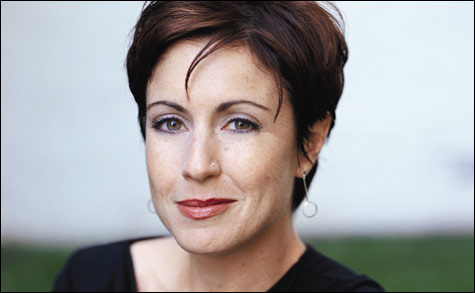
NUTS! By turns meaty and aggravating, Hornbacher’s shock-and-awe writing colors the entire book. |
| Madness: A Bipolar Life | By Marya Hornbacher | Houghton Mifflin | 320 pages | $25 |
Just reading this book exhausted me, so I can only imagine how tired Marya Hornbacher must have been after writing it. Or perhaps it came easily to her. Most things seem to.Depending on your taste, Horbacher’s casual brilliance is either infuriating or amazing. She has suffered from bipolar disorder since childhood but wasn’t diagnosed until her mid 20s. We first meet her as a 20-year-old, slicing her arm in a haphazard semi-suicide attempt and being hauled off to the hospital. “It is bloody, it looks like a raw steak, it looks like the word flesh, the word itself, in German fleis[c]h, and the Bastard of Hands has one hand wrapped around my forearm, his fingers and thumbs on either side of the gaping red thing, pressing it together, and he is sticking a needle into the inside part of the thing . . . and he stabs the inside of the thing again and again. . . . I realize I am a steak.” This kind of deliberate, shock-and-awe writing colors the entire book. Sometimes it’s meaty. Sometimes it’s aggravating.
Fortunately, even a wild spirit like Hornbacher is reined in by linear time. The book’s organization is chronological, dated sections taking us like a journal through her spates of madness. After the prologue arm-cutting incident, we see her at age four, flapping through her house, unable to go to sleep unless her mother plunges her into a warm bath. From there it’s on to her teens, snorting insane amounts of drugs, going away to boarding school, starving herself down to 52 pounds, then writing a critically acclaimed book (Wasted, about her eating disorders), ricocheting drunkenly from city to city and high to low and boyfriend to boyfriend until she finds herself in San Francisco, where she alights into an F.-Scott-and-Zelda existence with a suave, handsome man.
Life in California, according to Hornbacher: “The neon lights that blur in the rain and seem to smear across the sky; the open doors of bars spewing out laughing, shouting people and sucking more of them back in; the thundering, pounding bass in the clubs that seems to shake the street outside. And the parties, and the darling little restaurants, and the spectacular lofts, with their to-die-for views of the city and the bay, and the gorgeous clothes, . . . the endless, ever-present players playing their incessant little games, the stakes as high as a fortune to be made or lost overnight, or as small as getting the haughtiest woman in the room into bed. . . . ”
There’s little in the way of introspection on this wild ride. It’s difficult to understand how, given bouts with extreme eating disorders, massive intakings of drugs, and the attention span of a mosquito, she’s managed to survive, never mind churn out a book. This question is never addressed head-on. It’s implied that she’s just so high-functioning, so casually brilliant, the very thing that poisons her also sustains her. If not for her madness, who would she be? She’s the most self-satisfied crazy person I’ve run across. (“I’m the successful single girl, not a care in the world, I’m Mary Tyler Moore, tossing my hat in the air.”) A memoir like this demands sympathy from the reader, but if the writer herself doesn’t seem to want to get better — refusal to take her meds is a running theme — why should we keep turning the page?